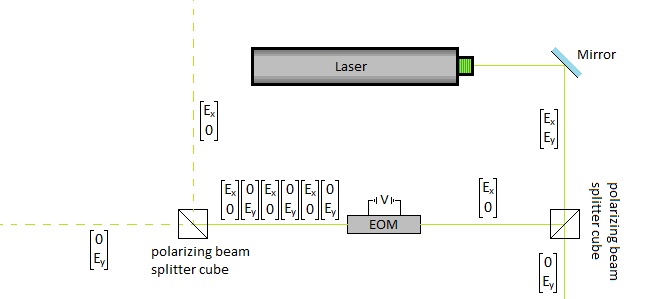I think it is important to talk a bit about the applications of an electro optic modulator. I think some of the modulation applications are fairly obvious. For example, phase modulation is useful when it comes to controlling what time and at what point in its oscillation a light wave will arrive somewhere. Also similar to phase modulation amplitude modulation allows for the control of the intensity.
The main perk of using an EoM as opposed to other less expensive optical elements is the ability to make the voltage time dependent or give it a frequency. The ability to turn the EoM on and off at rapid rates makes for some interesting applications.
One application I am most familiar with is the use of the polarization modulation to pulse a laser beam as shown below
Because of the rapid rate of turning on and off the EoM you get a laser coming out of it that is made up of alternating segments of horizontal and vertical polarization. After you send it through a polarizing beam splitter cube you get two pulsing laser beams.
The length of the pulses is directly proportional to the rate at which you turn the EoM on and off or the frequency which is the amount of times you turn it on in one second. To determine the pulse distance we can use this equation
(1) ![]()
Where c is the speed of light and f is the frequency at of the EoM
This is very useful to obtain time resolution and filter out noise. Let’s say you have an event that happens in a material and you wish to study it with a laser. If you pulse the laser beam at a known frequency then you are able to only look at events that are happening during the time you know the laser is affecting the material. Like wise you are able to see when it is not affecting the material at the same frequency. This allows you to see events that happen for only a short moment of time within a material.
If I had more time in this project I would do an experimental side, where I use a real EoM to learn more about them. One of the things i would do is determine the size of the crystal inside the EoM by using the phase shift and the known index of refraction. I would also like to assemble the various beam map set ups i came up with In this project and see how effective they are in modulating the laser.



As you said, being able to adjust the voltage allows you to adjust the phase for different wavelengths or create other types of polarization such as elliptical polarization.
I love how well your blog is organized! Really good job on keeping things separate neat. In the part where you explain the EoM itself, your diagram reminds me a lot of ones from when we looked at polarizable materials. Are the crystals in EoM’s ever polarizable? Is this useful for obtaining more extreme modulations from the EoM?
I’m a little confused about how pulsing the laser let’s you study very short events.
Is the event occurring because of the incident laser pulse or are you using the laser pulse to measure something that’s already going on?